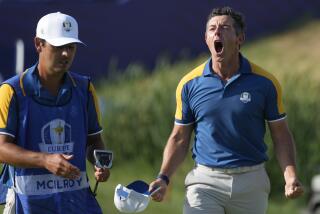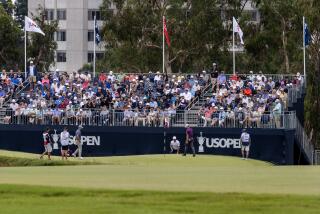Pate’s Fate Concerns U.S. : Ryder Cup: Team captain Dave Stockton won’t replace him and hopes the former UCLA star will be able to play Sunday.
- Share via
KIAWAH ISLAND, S.C. — If Steve Pate had not qualified for the U.S. Ryder Cup team, he would have been the first selection by team captain Dave Stockton, all of which makes Pate’s uncertain playing status even more disappointing to the Americans.
Pate, injured in a three-car accident Wednesday night, suffered a bruise to an abdominal muscle on his left side that affects his swing.
Also affected, if Pate cannot play, is the chance of the U.S. team to win back the Ryder Cup from Europe in the biennial event that begins today. Pate played so well this week in practice that Stockton planned to use him in five matches, beginning with the alternate-shot foursomes this morning. Pate, who would have played with Lanny Wadkins but will now be replaced by Hale Irwin, said he may be able to play Saturday and Sunday.
“I have played with tendinitis, a sprained ankle and a sprained toe--from hitting balls off a mat at Rancho Park,” the former UCLA player said at a news conference Thursday. “I won’t know when I can play until (today). It doesn’t bother me to walk around, but it’s hard to walk up and down stairs.”
This is not a good sign for Pate, since Wadkins likened walking the 7,400-yard Ocean Course to using a Stairmaster. The Ocean Course, laid out along a three-mile stretch bordering the Atlantic Ocean, is basically carved around saltwater marshes and dunes of fluffy, deep sand, making it a tedious walk for both golfers and spectators. The walk from the ninth hole to the 10th tee alone is a half-mile--although that sand is packed--for which architect Pete Dye offers this explanation: “My wife Alice says I got lost after the ninth hole and didn’t have a map.”
Said Wadkins: “It is the toughest walking course, tee to green, that I have ever played on.”
Pate received the bruise when he was thrown to the floor of a limousine carrying him and other members of the U.S. team from Kiawah Island to a dinner in Charleston, a 25-mile trip. His limousine, which he says was traveling about 55 m.p.h., was sandwiched between two others that were carrying other members of the U.S. team. Pate, the only player injured, said he was not wearing his seat belt. “I’m usually driving, and putting a seat belt on is automatic,” he said.
Stockton, who has worked at making this week a relaxed one for the team, instituted a skins games between the players, who spent most of the week chiding each other over their wins and losses. Stockton also arranged for a housing compound for the players, complete with a three-bedroom hospitality area where they “eat and party” and a two-room exercise suite.
When the players, shaken by the limousine accident and Pate’s injury, returned Wednesday night from the dinner, Stockton and his wife, Cathy, gave the players their team gift, a statue of an American Eagle on a base, and a copy of their team song, Randy Travis’ ‘Point of Light.’
“I didn’t plan on a limousine crash to pull us together,” Stockton said. “But we stayed up until midnight and talked about what we were going to do: Do we get a substitute or not?”
Stockton decided to go with the other 11 players and hope for Pate’s recovery. Not everyone on the team is required to play until Sunday’s 12 singles matches. If Pate isn’t ready, a provision will allow the European team also to pull a player and that match will be halved--each team receiving half a point.
Meanwhile, as a trainer was explaining the extent of Pate’s injuries, European team captain Bernard Gallacher and Stockton released the pairings for the first matches this morning. Each captain submits his pairings not knowing what the other has submitted. The pairings for the afternoon matches are submitted after the morning matches end.
The pairings are all-important in the strategy and outcome of this hole-by-hole competition, which has three match-play formats.
There are eight matches involving two-man teams on each of the first two days. In half of those matches, played in the morning sessions, players alternate shots using the same ball. In the afternoon matches, the format is better ball. Each team member plays his own ball, and the better score of the two decides the hole.
Each match victory is worth one point, with 28 total points available during the three days of competition.
Most of the pairings were predictable, the only surprise being Gallacher’s teaming of two Ryder Cup rookies in the third match--England’s David Gilford and Scotland’s Colin Montgomerie, who will face American veterans Wadkins and Irwin.
“I knew the Spaniards would be first and the veterans would be last, but the middle surprised me,” Stockton said.
Leading off for the U.S. team in alternate ball play will be the successful Ryder Cup team of Paul Azinger and Chip Beck against Spain’s Seve Ballesteros and Jose-Maria Olazabal.
Beck and Azinger won two matches while playing together in 1989. Ballesteros and Olazabal have won six matches together in the last two Ryder Cups.
The second match will pit long-hitting Fred Couples and Raymond Floyd, a crisp iron player, against Germany’s Bernhard Langer and England’s Mark James, the latter a veteran of Ryder Cup play and one of Gallacher’s at-large picks.
In the final match of the morning, U.S. Open champion Payne Stewart and Mark Calcavecchia will meet Masters champion Ian Woosnam and Nick Faldo.
Not playing in the morning are Europeans Sam Torrance, Steven Richardson, David Feherty and Paul Broadhurst, and Americans Mark O’Meara, Corey Pavin and Wayne Levi.
Levi earned his spot on the team by having an excellent 1990 season when he won four tournaments and was player of the year, but is ranked 79th on the money list this year.
More to Read
Go beyond the scoreboard
Get the latest on L.A.'s teams in the daily Sports Report newsletter.
You may occasionally receive promotional content from the Los Angeles Times.










